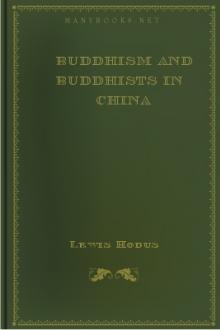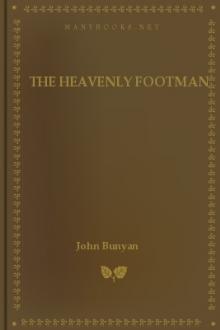Buddhism and Buddhists in China, Lewis Hodous [people reading books .TXT] 📗

- Author: Lewis Hodous
- Performer: -
Book online «Buddhism and Buddhists in China, Lewis Hodous [people reading books .TXT] 📗». Author Lewis Hodous
Project Gutenberg’s Buddhism and Buddhists in China, by Lewis Hodus
Copyright laws are changing all over the world. Be sure to check the copyright laws for your country before downloading or redistributing this or any other Project Gutenberg eBook.
This header should be the first thing seen when viewing this Project Gutenberg file. Please do not remove it. Do not change or edit the header without written permission.
Please read the “legal small print,” and other information about the eBook and Project Gutenberg at the bottom of this file. Included is important information about your specific rights and restrictions in how the file may be used. You can also find out about how to make a donation to Project Gutenberg, and how to get involved.
**Welcome To The World of Free Plain Vanilla Electronic Texts**
**eBooks Readable By Both Humans and By Computers, Since 1971**
*****These eBooks Were Prepared By Thousands of Volunteers!*****
Title: Buddhism and Buddhists in China
Author: Lewis Hodus
Release Date: June, 2005 [EBook #8390] [Yes, we are more than one year ahead of schedule] [This file was first posted on July 6, 2003]
Edition: 10
Language: English
Character set encoding: ISO-Latin-1
*** START OF THE PROJECT GUTENBERG EBOOK BUDDHISM AND BUDDHISTS IN CHINA ***
Produced by Lee Dawei, V-M Osterman and the Online Distributed Proofreading Team
BUDDHISM AND BUDDHISTS IN CHINA
BY
LEWIS HODOUS, D.D.
[Illustration: EX LIBRIS: CHARLES FRANKLIN THWING Western Reserve University Library
From the Library of Charles Franklin Thwing Acquired in 1938]
PREFACEThis volume is the third to be published of a series on “The World’s Living Religions,” projected in 1920 by the Board of Missionary Preparation of the Foreign Missions Conference of North America. The series seeks to introduce Western readers to the real religious life of each great national area of the non-Christian world.
Buddhism is a religion which must be viewed from many angles. Its original form, as preached by Gautama in India and developed in the early years succeeding, and as embodied in the sacred literature of early Buddhism, is not representative of the actual Buddhism of any land today. The faithful student of Buddhist literature would be as far removed from understanding the working activities of a busy center of Buddhism in Burmah, Tibet or China today as a student of patristic literature would be from appreciating the Christian life of London or New York City.
Moreover Buddhism, like Christianity, has been affected by national conditions. It has developed at least three markedly different types, requiring, therefore, as many distinct volumes of this series for its fair interpretation and presentation. The volume on the Buddhism of Southern Asia by Professor Kenneth J. Saunders was published in May, 1923; this volume on the Buddhism of China by Professor Hodous will be the second to appear; a third on the Buddhism of Japan, to be written by Dr. R. C. Armstrong, will be published in 1924. Each of these is needed in order that the would be student of Buddhism as practiced in those countries should be given a true, impressive and friendly picture of what he will meet.
A missionary no less than a professional student of Buddhism needs to approach that religion with a real appreciation of what it aims to do for its people and does do. No one can come into contact with the best that Buddhism offers without being impressed by its serenity, assurance and power.
Professor Hodous has written this volume on Buddhism in China out of the ripe experience and continuing studies of sixteen years of missionary service in Foochow, the chief city of Fukien Province, China, one of the important centers of Buddhism. His local studies were supplemented by the results of broader research and study in northern China. No other available writer on the subject has gone so far as he in reproducing the actual thinking of a trained Buddhist mind in regard to the fundamentals of religion. At the same time he has taken pains to exhibit and to interpret the religious life of the peasant as affected by Buddhism. He has sought to be absolutely fair to Buddhism, but still to express his own conviction that the best that is in Buddhism is given far more adequate expression in Christianity.
The purpose of each volume in this series is impressionistic rather than definitely educational. They are not textbooks for the formal study of Buddhism, but introductions to its study. They aim to kindle interest and to direct the activity of the awakened student along sound lines. For further study each volume amply provides through directions and literature in the appendices. It seeks to help the student to discriminate, to think in terms of a devotee of Buddhism when he compares that religion with Christianity. It assumes, however, that Christianity is the broader and deeper revelation of God and the world of today.
Buddhism in China undoubtedly includes among its adherents many high-minded, devout, and earnest souls who live an idealistic life. Christianity ought to make a strong appeal to such minds, taking from them none of the joy or assurance or devotion which they possess, but promoting a deeper, better balanced interpretation of the active world, a nobler conception of God, a stronger sense of sinfulness and need, and a truer idea of the full meaning of incarnation and revelation.
It is our hope that this fresh contribution to the understanding of Buddhism as it is today may be found helpful to readers everywhere.
The Editors.
New York city, December, 1923.
The Committee of Reference and Counsel of the Foreign Missions Conference of North America has authorized the publication of this series. The author of each volume is alone responsible for the opinions expressed, unless otherwise stated.
CONTENTS
CHAPTERI. INTRODUCTORY
II. THE ENTRANCE OF BUDDHISM INTO CHINA
III. THE ESTABLISHMENT OF BUDDHISM AS THE PREDOMINATING RELIGION OF CHINA 1. The World of Invisible Spirits 2. The Universal Sense of Ancestor Control 3. Degenerate Taoism 4. The Organizing Value of Confucianism 5. Buddhism an Inclusive Religion
IV. BUDDHISM AND THE PEASANT 1. The Monastery of Kushan 2. Monasteries Control F�ng-shui 3. Prayer for Rain (a) The altar (b) The prayer service (c) Its Meaning 4. Monasteries are Supported because They Control F�ng-shui
V. BUDDHISM AND THE FAMILY 1. Kuan Yin, the Giver of Children and Protector of Women 2. Kuan Yin, the Model of Local Mother-Goddesses 3. Exhortations on Family Virtues 4. Services for the Dead
VI. BUDDHISM AND SOCIAL LIFE 1. How the Laity is Trained in Buddhist Ideas 2. Effect of Ideals of Mercy and Universal Love 3. Relation to Confucian Ideal 4. The Embodiment of Buddhist Ideals in the Vegetarian Sects 5. Pilgrimages
VII. BUDDHISM AND THE FUTURE LIFE 1. The Buddhist Purgatory 2. Its Social Value 3. The Buddhist Heaven 4. The Harmonization of These Ideas with Ancestor Worship
VIII. THE SPIRITUAL VALUES EMPHASIZED BY BUDDHISM IN CHINA 1. The Threefold Classification of Men under Buddhism 2. Salvation for the Common Man 3. The Place of Faith 4. Salvation of the Second Class 5. Salvation for the Highest Class 6. Heaven and Purgatory 7. Sin 8. Nirvana 9. The Philosophical Background 10. What Buddhism Has to Give
IX. PRESENT-DAY BUDDHISM 1. Periods of Buddhist History 2. The Progress of the Last Twenty-five Years 3. Present Activities (a) The reconstruction of monasteries (b) Accessions (c) Publications (d) Lectures (e) Buddhist societies (f) Signs of social ambition 4. The Attitude of Tibetan Lamas 5. The Buddhist World Versus the Christian World
X. THE CHRISTIAN APPROACH TO BUDDHISTS 1. Questions which Buddhists Ask 2. Knowledge and Sympathy 3. Emphasis on the �sthetic in Christianity 4. Emphasis on the Mystical in Christianity 5. Emphasis on the Social Elements in Christianity 6. Emphasis on the Person of Jesus Christ (a) As a Historical Character (b) As the Revealer (c) As the Saviour (d) As the Eternal Son of God 7. How Christianity Expresses Itself in Buddhist Minds 8. Christianity’s Constructive Values
APPENDIX ONE, Hints for the Preliminary Study of Buddhism in China
APPENDIX TWO, A Brief Bibliography
BUDDHISM AND BUDDHISTS IN CHINA
I
INTRODUCTORY
A well known missionary of Peking, China, was invited one day by a Buddhist acquaintance to attend the ceremony of initiation for a class of one hundred and eighty priests and some twenty laity who had been undergoing preparatory instruction at the stately and important Buddhist monastery. The beautiful courts of the temple were filled by a throng of invited guests and spectators, waiting to watch the impressive procession of candidates, acolytes, attendants and high officials, all in their appropriate vestments. No outsider was privileged to witness the solemn taking by each candidate for the priesthood of the vow to “keep the Ten Laws,” followed by the indelible branding of his scalp, truly a “baptism of fire.” Less private was the initiation of the lay brethren and sisters, more lightly branded on the right wrist, while all about intoned “Na Mah Pen Shih Shih Chia Mou Ni Fo.” (I put my trust in my original Teacher, S�kyamuni, Buddha.)
The missionary was deeply impressed by the serenity and devotion of the worshipers and by the dignity and solemnity of the service. The last candidate to rise and receive the baptism of branding was a young married woman of refined appearance, attended by an elderly lady, evidently her mother, who watched with an expression of mingled devotion, insight and pride her daughter’s initiation and welcomed her at the end of the process with radiant face, as a daughter, now, in a spiritual as well as a physical sense. At that moment an attendant, noting the keen interest of the missionary, said to him rather flippantly, “Would you not like to have your arm branded, too?” “I might,” he replied, “just out of curiosity, but I could not receive the branding as a believer in the Buddha. I am a Christian believer. To be branded without inward faith would be an insult to your religion as well as treachery to my own, would it not? Is not real religion a matter of the heart?”
The old lady, who had overheard with evident disapproval the remark of the attendant, turned to the missionary at once and said, “Is that the way you Westerners, you Christians, speak of your faith? Is the reality of religion for you also an inward experience of the heart?” And with that began an interesting interchange of conversation, each party discovering that in the heart of the other was a genuine longing for God that overwhelmed all the artificial, material distinctions and the human devices through which men have limited to particular and exclusive paths their way of search, and drew these two pilgrims on the way toward God into a common and very real fellowship of the spirit.
A Buddhist monk was passing by a mission building in another city’ of China when his attention was suddenly drawn to the Svastika and other Buddhist symbols which the architect had skilfully used in decorating the building. His face brightened as he said to his companion: “I did not know that Christians had any appreciation of beauty in their religion.”
These incidents reveal aspects of the alchemy of the soul by which the real devotee of one religion perceives values which are dear to him in another religion. The good which he has attained in his old religion enables him to appropriate the better in the new religion. A converted





Comments (0)